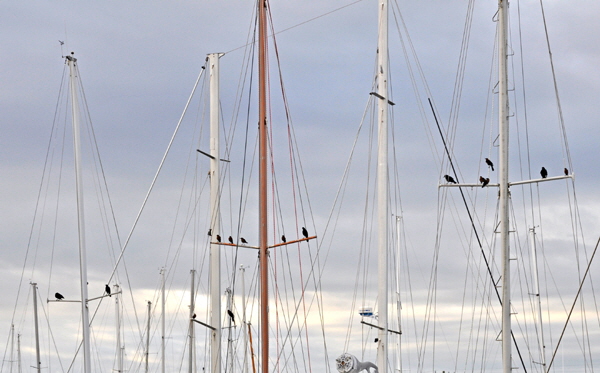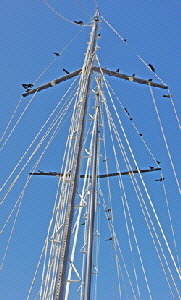 There are surely few things more upsetting to an owner who takes pride in his boat than arriving for a nice weekend sailing to find the decks covered in bird droppings! This happened to us on a regular basis because where we kept Britannia in Westland Marina, Titusville, Florida, is next to a public park with lots of trees. They are full of hoards of blackbirds, starlings, crows and pigeons that roost and feed on the berries, then fly over and do their dirty work all over the boats. This is a serious problem at this marina because if the acidic excrement is not washed off, decks can be permanently stained, paintwork and varnish will discolor and canvas, sails and ropes will rot. The obvious answer is to try and deter the pesky critters from landing on your boat in the first place, but this is easier said than done, especially on a sailboat with so many perfect perches.
There are surely few things more upsetting to an owner who takes pride in his boat than arriving for a nice weekend sailing to find the decks covered in bird droppings! This happened to us on a regular basis because where we kept Britannia in Westland Marina, Titusville, Florida, is next to a public park with lots of trees. They are full of hoards of blackbirds, starlings, crows and pigeons that roost and feed on the berries, then fly over and do their dirty work all over the boats. This is a serious problem at this marina because if the acidic excrement is not washed off, decks can be permanently stained, paintwork and varnish will discolor and canvas, sails and ropes will rot. The obvious answer is to try and deter the pesky critters from landing on your boat in the first place, but this is easier said than done, especially on a sailboat with so many perfect perches.
Britannia is a schooner that has twice the potential landing sites as a sloop including a triatic stay between the masts. Sometimes I would see twenty of the little darlings on this stay all chirping away merrily. Below in the direct line of their fire is my new roller furled ‘tweenmast staysail.
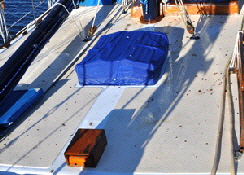 Small birds are not the only nuisances. I have disturbed pelicans perched on my davits and they really know how to poop! as do cormorants. There is also a resident osprey who once pecked my wind vane to pieces and it cost $70 to replace, and he lives in a fine nest on top of a nearby telephone pole, provided by the City of Titusville rent free! Some people have their priorities wrong.
Small birds are not the only nuisances. I have disturbed pelicans perched on my davits and they really know how to poop! as do cormorants. There is also a resident osprey who once pecked my wind vane to pieces and it cost $70 to replace, and he lives in a fine nest on top of a nearby telephone pole, provided by the City of Titusville rent free! Some people have their priorities wrong.
An initial search on the web for “bird deterrents for sailboats” brings up a withering display of products all of which claim to deter birds. There are also independent reports and forum threads dealing with specific products, but that are not quite so effervescent as manufacturer's claim. Products range from the ubiquitous plastic owl, that I have actually seen a real bird sitting on, to sophisticated devices like an imitation peregrine falcon kite designed to swoop in the breeze from a fifteen foot pole. Many devices must be removed when you want to go sailing and you obviously can't sail with something rotating around on your main or mizzen boom, so these type of things need to be easily removable. Other products that fit on mastheads, radomes, davits or spreaders, etc. can be left in place.
I sent a letter to ten manufacturers asking if they were interested in supplying any devices they had for sailboats and I received products from five. (see below). It can be quite complex and expensive to decide that you need to cover each area of your boat.
Beginning at the top, i.e. the masthead, and working down:
MASTHEADS
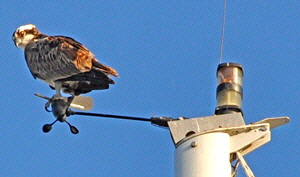
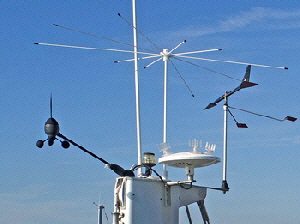 Mastheads are fairly easy to protect. Stopgull and Bird-B-Gone have a series of “spiky rods” that rotate freely and unbalance a bird trying to land. The rods can be adjusted in height to clear a wind vane or antenna and rods can be removed to still allow the device to move a little.
Mastheads are fairly easy to protect. Stopgull and Bird-B-Gone have a series of “spiky rods” that rotate freely and unbalance a bird trying to land. The rods can be adjusted in height to clear a wind vane or antenna and rods can be removed to still allow the device to move a little.
A different concept is a “spider” supplied by Bird-B-Gone that is a series of thin wobbly wires hanging like spider legs. These prevent birds from landing, but cannot be used where a wind vane is fitted. Both devices stop birds landing on mastheads.
So far so good.
One thing I had to try for my 14’ foot long triatic stay was a predatory bird decoy made by StopGull. This is a 24” inch wingspan Peregrine Falcon kite that flies in a very realistic manner from a length of nylon line off a 15’ foot fiberglass pole. I hoisted it to the top of my mainmast using the gantline that ensured it remained above the masthead and did not tangle with the triatic. The kite flew in even a slight breeze and 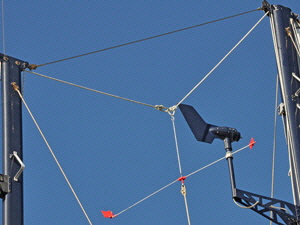 did deter birds from coming near, even our resident Osprey. However I don't know how long it will last in a good blow, and it was also difficult to hoist and lower in any wind.
did deter birds from coming near, even our resident Osprey. However I don't know how long it will last in a good blow, and it was also difficult to hoist and lower in any wind.
Gullsweep supplied a rotator that hangs upside down that I hoisted it between my masts in the hope of getting it high enough to frighten birds off the triatic. I think it might have been quite effective but my wind generator got in the way. Any two masted rig would need a halyard from each mast along with a deck tether. Then it would be quite easy to hoist up and down.
The problem of course with all wind driven devices is that they are useless when there is no wind. I guess I will just have to keep my 12 gauge shotgun loaded…
Radomes and flat TV antennas:
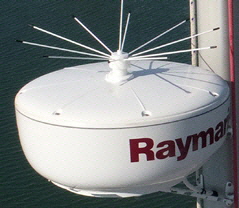 Here I used one “spiky rod” and one “spider”. I didn't want to drill into the top of either platform so I glued them on with epoxy. They were both effective in stopping birds landing but I wonder if they will still be there after the next east coast hurricane.
Here I used one “spiky rod” and one “spider”. I didn't want to drill into the top of either platform so I glued them on with epoxy. They were both effective in stopping birds landing but I wonder if they will still be there after the next east coast hurricane.
SPREADERS:
 Britannia’s mainmast spreaders are each 6’ feet long and the foremast are 5’ feet, that are quite a length to protect. Stopgull supplied a wire to be attached to the cap shroud about 3” inches above the spreader and held taught at the mast by bungee cord. This prevented birds landing but bungee cord does not hold up long in the Florida sun. A stainless spring would be more resilient.
Britannia’s mainmast spreaders are each 6’ feet long and the foremast are 5’ feet, that are quite a length to protect. Stopgull supplied a wire to be attached to the cap shroud about 3” inches above the spreader and held taught at the mast by bungee cord. This prevented birds landing but bungee cord does not hold up long in the Florida sun. A stainless spring would be more resilient.
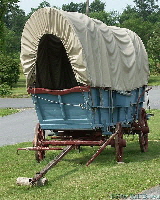
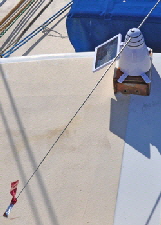 A device with a series of plastic spikes supplied by Bird-B-Gone fastened all the way along the spreader with cable ties. This also stopped birds landing. The brads prick the birds feet and they don't like it.
A device with a series of plastic spikes supplied by Bird-B-Gone fastened all the way along the spreader with cable ties. This also stopped birds landing. The brads prick the birds feet and they don't like it.
Unless you are very agile, (and also brave), you should perhaps employ a professional rigger to install these things. Attaching anything along spreaders requires swinging precariously out along the spar, but once installed they don't need to be removed.
I also found a flexible electric strip that gives a slight shock to birds when they land on it, but it would be very difficult to install high on a sailboat and I didn't try. Its a pity nobody makes a system to electrify the whole rig with 3,000 volts!! That would get rid of ‘em, but the problem then would be a deck littered with fried birds, and perhaps the occasional marina employee, followed by a whole lot of vultures and no doubt lawyers.
Booms, with or without sails or covers:
 I found the simplest device to be the long rotating arms. These are available 6’ feet and 8’ feet in diameter mounted with adjustable straps on a bare boom or over a sail cover. Straps are easily unclipped when you want to go sailing. They were offered by Bird-B-Gone, Stopgull and Gullsweep. They rotate in even a slight breeze and effectively deter birds landing nearby but only if there is wind. Bird-B-Gone has a solar powered version that works when there is no wind.
I found the simplest device to be the long rotating arms. These are available 6’ feet and 8’ feet in diameter mounted with adjustable straps on a bare boom or over a sail cover. Straps are easily unclipped when you want to go sailing. They were offered by Bird-B-Gone, Stopgull and Gullsweep. They rotate in even a slight breeze and effectively deter birds landing nearby but only if there is wind. Bird-B-Gone has a solar powered version that works when there is no wind.
Biminis, decks and cabin tops:
If you have clearance above your Bimini rotating arms would again be an effective deterrent and Stopgull offers an adapter that clamps through a canvas Bimini. If you have a solid cockpit top or for any hard surface a “sandbag” adapter is made to mount a rotator. This is heavy enough to stay in place and easy to place on any flat surface.
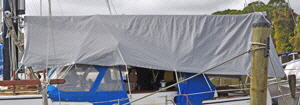
 I always spread a simple tarp’ awning over my main boom and Bimini when in port. This protects the boom, the entire Bimini and part of the after deck against droppings from on high. Plastic tarps are available in many different sizes and relatively inexpensive from hardware stores. They also protect a canvas Bimini against rain and sun in addition to keeping the cockpit cooler, but they can be tiresome to scramble under. If you covered the whole boat it might even obviate the need for anything on your masts But such a cover can be very expensive.
I always spread a simple tarp’ awning over my main boom and Bimini when in port. This protects the boom, the entire Bimini and part of the after deck against droppings from on high. Plastic tarps are available in many different sizes and relatively inexpensive from hardware stores. They also protect a canvas Bimini against rain and sun in addition to keeping the cockpit cooler, but they can be tiresome to scramble under. If you covered the whole boat it might even obviate the need for anything on your masts But such a cover can be very expensive.
Shadetree Fabric Shelters supplied a very well made Dacron awning supported by demountable flexible rods passing through from one side to the other to create an arch, clear of booms and sails. It made the aft section look a bit like a Conestoga covered wagon, but allowed easy companionway access. The clearance allowed wind to blow through between the awning and Bimini and it didn't flap around like a tarp. This worked well but at a cost of $700 for Britannia it was beyond my budget at that time. Setting awnings up and taking them down can be tedious, especially if you sail regularly, but a good rain shower will usually wash bird dropping off awnings.
 Static devices placed on decks don't seem to deter birds for long, they quickly realize the owl, eagle or snake is false. It is things that move irregularly that frighten them away.
Static devices placed on decks don't seem to deter birds for long, they quickly realize the owl, eagle or snake is false. It is things that move irregularly that frighten them away.
One package that arrived from Bird-B-Gone contained a headless and tailless black cat. Assembly consisted of simply shoving its head on one end and its tail on the other on wobbly springs, and it became quite a cute little sprog’. I placed it on my deck and no birds came near it. However, it still didn't stop them dropping their loads from above and after a few days the poor thing began to look like it needed to go to the groomers.
Rails and safety lines:
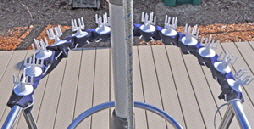
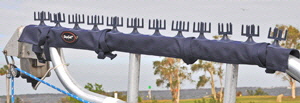 Stopgull supplied 3’ foot long canvas strips with plastic candelabra looking spikes mounted every 3” inches. These rotate and upset a bird’s balance when they try to land on them. They can be strapped along a rail, pushpit or pulpit and don't need removing. I fitted one strip on the forward rail of my pulpit but fitting them to the sides would have impeded the jib. I fitted two more to my davit arms that effectively stopped birds landing including pelicans. They are also available in self adhesive single units, to stick on things like navigation lights.
Stopgull supplied 3’ foot long canvas strips with plastic candelabra looking spikes mounted every 3” inches. These rotate and upset a bird’s balance when they try to land on them. They can be strapped along a rail, pushpit or pulpit and don't need removing. I fitted one strip on the forward rail of my pulpit but fitting them to the sides would have impeded the jib. I fitted two more to my davit arms that effectively stopped birds landing including pelicans. They are also available in self adhesive single units, to stick on things like navigation lights.
Acoustic devices:
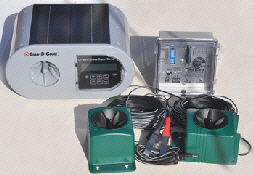 All the above devices only protected sections of a sailboat, but acoustic deterrents claim to cover amazingly large areas even a complete marina! I tried two very sophisticated looking units supplied by Birdgard and Bird-B-Gone.
All the above devices only protected sections of a sailboat, but acoustic deterrents claim to cover amazingly large areas even a complete marina! I tried two very sophisticated looking units supplied by Birdgard and Bird-B-Gone.
A speaker emits different distressed bird calls that cause them to flee the area. These can be programmed to upset individual species or rotate through a number of common types. One unit was solar powered for outside use and sat on my deck. The other had two separate speakers that I ran half way up my masts on halyards then I tried each unit separately. The calls are quite strident and Britannia began to sound like an aviary and the cacophony soon become as annoying as the real bird cries. Volume and duration can be controlled and they shut off automatically at night when birds are less prevalent. But if you left one of these squawking all day I can imagine there would be complaints, birds or no birds. Birdguard’s model with separate speakers seemed to be more effective overall, but both units frightened the smaller birds that contaminate Westland Marina. Incredibly though our resident osprey actually seemed to be attracted to the calls and they also seemed to upset two Jack Russell terriers on a boat a few slips away.
These devices are much more expensive than individual products, in the region of $200-$400, but on adding up the cost of all the separate devices needed to protect a sailboat completely the cost came to about the same.
There are many other products: imitation snakes placed around the deck, the good old plastic owl and other quite impressive bird decoys, shiny disks that flutter in the breeze, balloons, and a myriad of other things. Some of these struck me as more gimmicky than effective, but I did not test them.
CONCLUSIONS:
Individual devices can prevent birds perching on mastheads, spreaders, radars, booms, rails, etc. and these undoubtedly reduce defecation on decks. But birds still manage to cling to rigging wires even those that are vertical. When technology allows us to talk to the animals as I am sure it eventually will, they will tell us how they laughed at our poor attempts to stop them playing around on our boats.
The acoustic deterrents are the only things that cover a complete boat and are easy to set up and remove. But even these didn't stop determined birds landing during the one or two minute intervals between calls, and the devices definitely can become annoying and noisy.
I finally came to the conclusion that the only way to keep a sailboats decks entirely free from droppings is with awnings, that don't rely on wind and are also silent. You can read about the type of awning I finally made here.
During this fascinating review Britannia also attracted much curiosity with all its appendages, especially the flying falcon and spinning arms that made it look like a drone ready to lift off.
The disgusting bird droppings problem eventually became so annoying that I decided to move Britannia to a cleaner marina. After all, that's a benefit of having a boat, if you don't like the locals or the surroundings, you can always move.
